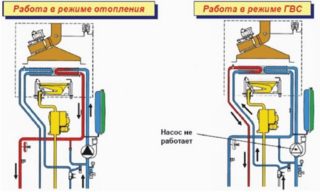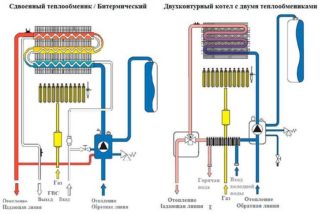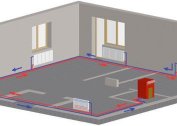A double-circuit gas boiler is used for autonomous heat supply. It is convenient in that it can serve two engineering networks at once - heating and hot water supply. When using such a device, there is no need to purchase a water heater. It is convenient to use a water heater in the summer when heating is not needed. This is possible thanks to the summer mode, in which all the heat is spent on water. Before buying a boiler, you should familiarize yourself with its device, the principle of operation and operating modes.
Instrument design
 A double-circuit boiler is a device that heats a room and heats water. To understand how the heating device works, you should understand what it consists of. In the design of the boiler there are components that are responsible for heating the coolant and switching to the hot water circuit. While ensuring the stable operation of all parts, uninterrupted operation of the device will be implemented.
A double-circuit boiler is a device that heats a room and heats water. To understand how the heating device works, you should understand what it consists of. In the design of the boiler there are components that are responsible for heating the coolant and switching to the hot water circuit. While ensuring the stable operation of all parts, uninterrupted operation of the device will be implemented.
In the circuit of the device, regardless of its type, there are the following details:
- Burner. It is installed in the combustion chamber. It is the main working part of the heating structure. The main task is heating the coolant and generating heat for the operation of the water heating circuit. To maintain accurate temperature, it is equipped with an electronic flame modulation system.
- The combustion chamber. It is open and closed. It is a housing for the burner. In a closed chamber there is a fan that accelerates air and removes combustion products. It gives a little noise during operation.
- Circular pump. Provides circulation of the heat carrier through the heating system and the water heater circuit. It runs silently.
- Three-way valve. Responsible for switching the heating circuit to water supply and vice versa. Depends directly on the tap.
- The main heat exchanger. In this part, the heating medium is heated. It is installed above the burner in the storage chamber.
- Secondary heat exchanger. Responsible for the preparation of hot water.
- Instrument automation system. Sensors installed in the heater monitor the parameters of the equipment, are responsible for safety, activate various nodes, detect and correct errors and perform a number of other useful functions.
Water is supplied through a special tube in the lower part of the housing. It is also discharged through a pipe that connects to the tap. It is important to note that during operation, the heat exchanger does not mix with water.
Some installations have a dual heat exchanger. The principle of its operation remains unchanged, although the design is slightly different.
Operating principle
 Each part in the design performs its function. The principle of operation will be considered in two modes - heating and hot water generation. In a separate group stands out the summer mode, when heating the house is not required.
Each part in the design performs its function. The principle of operation will be considered in two modes - heating and hot water generation. In a separate group stands out the summer mode, when heating the house is not required.
Work in heating mode
In this mode, the boiler acts as a heater. Simultaneous work on heating the room and water is impossible.
As a heating device, the boiler operates on the same principle as a conventional flow heater. First, the device turns on and warms up to the declared temperature. When the limit is reached, the gas supply stops. If the boiler is equipped with a temperature sensor, the automation will take these readings into account.
The operation of the burner is also affected by the automation that measures the temperature of the street air. Sensors allow the boiler to be used only in cold weather. This significantly saves energy.
A working gas burner generates heat.It heats the coolant, which then circulates through the heating system, heating the room. During operation, combustion products are formed, which are removed in two ways - using a fan or independently. Water heating off. A three-way valve is responsible for this.
Operation in water heating mode
The water circuit is activated when the user turns the water tap. When a water stream is supplied, a three-way switch is activated and the heating system is turned on. At the same time, a gas burner is ignited, after which warm water starts to flow from the tap. When the boiler enters the hot water supply mode, the heating circuit switches off.
After the valve is turned off, the three-way valve is reset and the secondary heat exchanger is cut off. All energy is directed to the heating system.
Space heating is required only in the cold season, unlike water heating, which is necessary constantly. In this case, the boiler is switched to summer operation. It is activated by pressing the appropriate button on the device. A three-way valve cuts off the heating line and the coolant is circulated in a closed circuit inside the boiler.
Bithermic heat exchanger boiler
 Devices with bithermic heat exchangers operate on the principle of “pipe in pipe”. This means that one large pipe is divided into several parts along, which are fenced with metal tight parts. Vessels are not reported.
Devices with bithermic heat exchangers operate on the principle of “pipe in pipe”. This means that one large pipe is divided into several parts along, which are fenced with metal tight parts. Vessels are not reported.
The coolant circulating through the external part of the tube enters the heating system. Water appears in the inside after opening the tap. When the user turns the faucet in the sink, the heating circuit is closed and all the energy is spent on heating the water. The circulation pump is inactive at this time.
When the hot water supply stops, the pump is activated and the coolant enters the heating circuit. Models with a bithermic heat exchanger require fewer sensors and automation. As a result, the cost of such products is higher, and the efficiency in the mode of heating water is greater and reaches 93.4%.
The disadvantages include the risk of clogging of the pipe. Manifested in case of leakage and poor sealing of the tubes. In this case, cleaning the heat exchanger is quite difficult; specialist assistance may be required.
Heat exchanger selection
When buying a double-circuit gas boiler, it is important to decide in advance which type of heat exchanger is needed. The main criteria by which you can make the right choice:
- Is there a need for quick heating of water. If so, models with a bithermic heat exchanger should be preferred. The liquid will heat directly from the burner, so less gas and electricity are required. In this case, the temperature will be maintained more accurate.
- Devices with separate heat exchangers practically do not clog. Failed pipes can be replaced. In the event of a breakdown in the bithermic device, both circuits will not work. Flushing such a heat exchanger is more difficult.
- The throughput of devices with a separate heat exchanger is higher, since the pipe is not divided into sections. The device arranged in a double way allows less heat transfer.
- Climatic conditions must be considered. When working in summer mode, it is more profitable to buy a bithermic heat exchanger.
- The cost of a bithermic heat exchanger is more than separate.
Bithermic heat exchanger is more difficult to operate, but it has smaller dimensions.
Advantages and disadvantages
The positive qualities of a dual-circuit gas boiler include:
- Economical fuel consumption. Automation makes the use of such models even more profitable, as it disconnects and connects as needed. Work in the summer also saves fuel and money.
- Compactness.The loop boiler can be placed in a small utility room or in a small kitchen. Floor models are slightly larger than wall models.
- Universality. No need to purchase additional parts and a boiler.
- Combination in one casing of a water heater, heating device and circulation pump.
Among the minuses, it is possible to single out the impossibility of simultaneously heating water and heating and limiting the power of wall-mounted appliances. The heat exchanger is also sensitive to water quality. The principle of operation of a double-circuit boiler is more complicated than a single-circuit one, but the first one is more profitable to buy at a cost.
There are a number of points that you need to pay attention to in order to choose a dual-circuit gas boiler: operating principle, circuit, power, type of heat exchanger, manufacturer. Preference should be given to models from well-known companies.
Many well-known brands are engaged in the production of water heating and heating devices, including Bosch, Ariston, Wisman, Navien. The leading places in the ratings are occupied by Buderus Logamax U072-24K, Lemax PRIME-V32, Navien DELUXE kotel 24K. All products are of high build quality, good performance, warranty.



